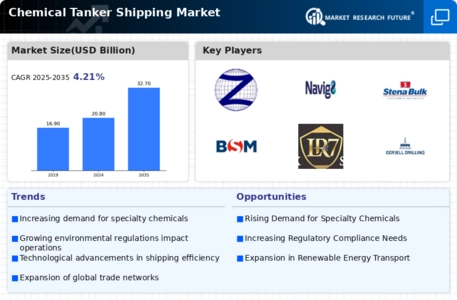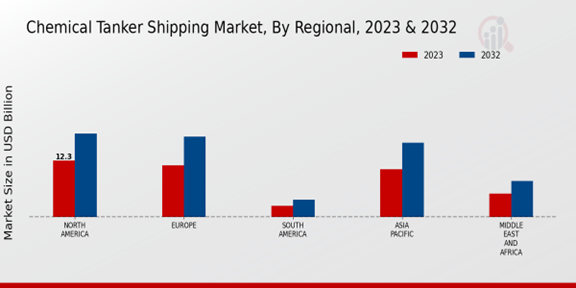Market Growth Projections
The Global Chemical Tanker Shipping Market Industry is projected to experience substantial growth over the next decade. With a market value of 20.8 USD Billion in 2024, the industry is expected to reach 32.7 USD Billion by 2035, indicating a robust expansion. The anticipated compound annual growth rate (CAGR) of 4.21% from 2025 to 2035 further underscores the positive outlook for the sector. This growth can be attributed to various factors, including rising demand for chemicals, regulatory compliance, and technological advancements. The market's trajectory suggests a dynamic environment, where stakeholders must remain agile to capitalize on emerging opportunities.
Rising Demand for Chemical Products
The Global Chemical Tanker Shipping Market Industry experiences a notable increase in demand for various chemical products, driven by the growth of industries such as pharmaceuticals, agriculture, and manufacturing. As these sectors expand, the need for efficient transportation of chemicals becomes paramount. In 2024, the market is valued at approximately 20.8 USD Billion, reflecting the industry's capacity to adapt to the evolving needs of global supply chains. This trend is expected to continue, with projections indicating a market value of 32.7 USD Billion by 2035, suggesting a robust growth trajectory fueled by the rising consumption of specialty chemicals.
Technological Advancements in Shipping
Technological advancements play a crucial role in shaping the Global Chemical Tanker Shipping Market Industry. Innovations such as digitalization, automation, and improved vessel design enhance operational efficiency and reduce environmental impact. The adoption of smart shipping technologies allows for better route optimization and fuel management, which can lead to cost savings. Furthermore, advancements in cargo handling systems improve the safety and efficiency of chemical transportation. As the industry embraces these technologies, it is likely to attract new investments and partnerships, thereby contributing to the overall growth of the market.
Environmental Sustainability Initiatives
The Global Chemical Tanker Shipping Market Industry is increasingly influenced by environmental sustainability initiatives aimed at reducing the carbon footprint of shipping operations. As global awareness of climate change intensifies, shipping companies are adopting greener practices and technologies to comply with international environmental regulations. This shift not only enhances the industry's image but also attracts environmentally conscious clients. Investments in eco-friendly vessels and alternative fuels are becoming more common, suggesting a potential for growth in the market as companies strive to balance profitability with sustainability. The focus on environmental responsibility may also lead to new business opportunities in the sector.
Global Trade Dynamics and Economic Growth
The Global Chemical Tanker Shipping Market Industry is closely linked to global trade dynamics and economic growth. As economies recover and expand, the demand for chemical transportation increases, driven by the need for raw materials and finished products across borders. Emerging markets, in particular, present significant opportunities for growth as industrialization accelerates. The projected compound annual growth rate (CAGR) of 4.21% from 2025 to 2035 indicates a steady increase in shipping activities, reflecting the industry's adaptability to changing economic conditions and trade patterns. This growth is essential for meeting the rising global demand for chemicals.
Regulatory Compliance and Safety Standards
The Global Chemical Tanker Shipping Market Industry is significantly influenced by stringent regulatory compliance and safety standards imposed by international maritime organizations. These regulations aim to ensure the safe transportation of hazardous materials, thereby enhancing the industry's reputation and operational efficiency. Companies are increasingly investing in advanced technologies and training programs to meet these standards, which may lead to higher operational costs but ultimately results in safer shipping practices. The emphasis on compliance not only mitigates risks but also fosters trust among stakeholders, potentially driving market growth as companies seek reliable shipping partners.



 Source: Primary Research, Secondary Research, Market Research Future Database and Analyst Review
Source: Primary Research, Secondary Research, Market Research Future Database and Analyst Review















